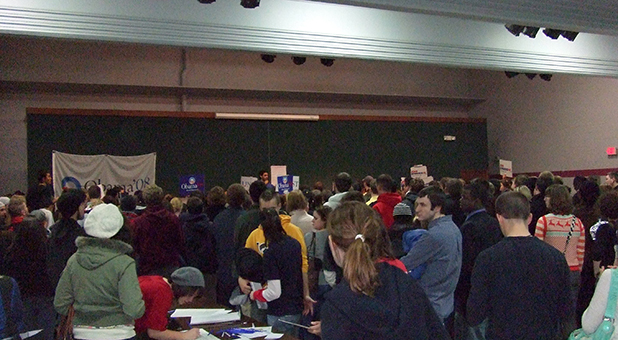In Iowa, on Feb. 1, there won’t be a single caucus, nor will there be two—one for each of the major political parties—there will be nearly 3,400.
The caucuses happen at the precinct level, where as many as several hundred people, to as few as five or six, gather to not only make their pick for who they think should be the next president of the United States, but to chart our nation’s future as well. It is American self-government in its most original state.
Republicans and Democrats alike will participate—independents who want to join in are welcome to do so, but must register for the party they have chosen to caucus with—but the processes are not identical. Yes, they will both choose presidential candidates to support, and yes, they will both begin the process of forming their parties’ platforms.
But it’s how they do it that makes all the difference. So let’s first look at the Democrats and their caucus process. Before you do, you’ll want to make sure you have access to a calculator, a slide rule and some scratch paper, because it requires some math skills.
Oh, and don’t forget to bring a plate of your favorite treat to share.
Step One: Be Prepared
Are you registered to vote? If not, that’s OK. You can do that at your precinct caucus site. You must be declared as, in this case, a Democrat to participate. Also, those who are 17 years old, but will be 18 by Election Day 2016 (Tuesday, Nov. 8), are also allowed to participate in the caucus process.
You also need to know where you will caucus. Your voter registration card will tell you which precinct you belong to, or if you’re unsure (or aren’t registered), the Iowa Secretary of State’s Office website can help you find it.
Unlike primary elections, which are held the first Tuesday of June in even-numbered years in Iowa, the caucus is a function of the parties, not the state’s election process. So in the days leading up to the caucus, the local county central committee will publish the locations for all of the precinct caucuses.
The Secretary of State’s Office website also has a listing of precinct location sites. Type in your address at the link above, and you will be offered the lists for both parties’ caucus locations.
The fun begins promptly at 7 p.m., so be sure to get there early, especially if you have to register as a Democrat to participate. In 2008, with record turnout, those who were in line to check in by 7 p.m. were still allowed to participate.
As a Democrat, this also affords you more time to mingle and to start planting the seeds for the candidate you wish to support. This will be important in the later steps.
Step Two: Preliminary Business
Each precinct caucus will already have a “temporary chair” assigned. His or her duty is to facilitate the beginning of the caucus and to take care of preliminary business. This includes:
- Previewing the meeting agenda
- Explaining the purpose of the precinct caucus—to select a presidential preference, to elect delegates to county convention, to adopt platform resolutions and to elect precinct leadership
- Reading any correspondence and announcing candidate nominating petitions
- Conducting the election of permanent precinct caucus officers
Once that final duty is concluded—it’s fairly common for the temporary chair to be elected the permanent chair—the caucus is ready to begin in earnest.
Step Three: Determining Viability
Delegates to the county convention will be selected from what are called “preference groups,” which are groups of people who share an interest in a common candidate. But in order to be eligible to send delegates to convention, a preference group must first meet the “viability” requirement.
In other words, a minimum number of caucus attendees must be a part of the preference group. This is where the calculation equipment comes in handy.
Viability is first determined based on the number of caucus participants who are eligible to vote. It is also based on the total number of delegates that precinct will send to county convention, which is byproduct of Democrat turnout in the 2012 General Election.
If the precinct is sending two delegates, a preference group must include at least 25 percent of the attendees in order to be considered viable. In precincts awarded four or more delegates, a preference group must include at least 15 percent of the attendees to be considered viable.
Here’s an example:
The Anytown 2 Precinct is awarded five delegates, and has a caucus attendance of 75 voters. Using the 15 percent viability threshold, the math looks something like this:
75 x .15 = 11.25
In this example, the viability threshold is 12 voters.
Step Four: Realigning and Awarding Delegates
If a preference group is not determined to be viable, its members must join another preference group. There are a lot of methods that can be used to convince voters to change preference groups—this is where the plate of goodies comes into play.
This process, called “realignment,” takes about 30 minutes. Voters from one nonviable group may join another in an attempt to make it viable, and voters from viable groups can leave to join another group (during the first realignment only).
The realignment process is repeated as many times as necessary until all of the awarded delegates can be assigned to candidates. These delegates are awarded through another mathematic calculation.
The total number of people in a preference group is divided by the total number of caucus attendees eligible to vote and then multiplied by the number of delegates that will be sent to the county convention. The resulting number—rounded up for fractions of a delegate more than 0.5 and down for fractions less than 0.5—is the number of delegates awarded.
Let’s look at the example:
Candidate A’s preference group in the Anytown 2 Precinct (see above) had 32 people in it. So, the resulting calculation would look like this:
32 ÷ 75 x 5 = 2.13
In this example, Candidate A will receive 3 delegates for the county convention. The delegates will be elected from within the preference group. The group may also elect as many alternates as they want, although alternates may only fill in at county convention if an elected delegate is unable to attend.
Some caucuses may postpone the consideration of platform resolutions until after the picking of preference groups. Otherwise, the caucus will end once the delegates and alternates have been selected.
But the process is far from over.
Step Five: The Delegate Climb
The delegates elected at a precinct caucus could potentially wind up as delegates at the Democratic National Convention. The first step is to go to the county convention, where one becomes a district and/or state convention delegate.
County conventions will take place Saturday, March 12, in each of Iowa’s 99 counties. District conventions will be held Saturday, April 30, in each of Iowa’s four congressional districts. The Iowa Democratic State Convention will be held Saturday, June 18.
Iowa will send 52 delegates to the national convention.
And there you have it, the entire caucus process. If you would like to “see” it—with a fun little animation—the Iowa Association of Business and Industry and Economic Progress for Iowa’s Citizens have jointly put together a video tutorial. Click here to see the video.
Next week, we’ll look at the Republican caucus process.
See an error in this article?
To contact us or to submit an article






















